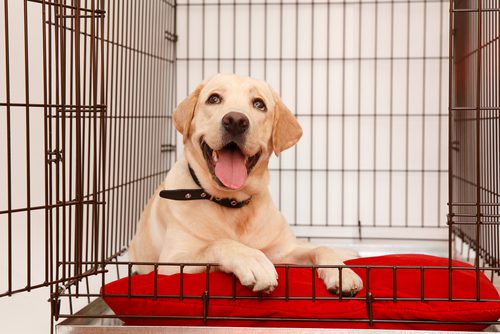
Crating began as a way for people to housetrain puppies. And, when used appropriately, using a crate can aid puppies with toilet training, keep them out of harm’s way, and help them to learn to be left alone for a short time. But, once out of puppyhood, is there still a need for them?
In terms of older dogs, the RSPCA states: “Adult dogs that have been successfully trained to have a positive association with their crate and view it as their safe haven are normally quite happy to be left for about three hours.”
However, the charity also warns against ever using a crate as a form of punishment, stating: “Your dog’s crate should be a place where he/she feels secure, safe and comfortable. Crates must never be used as a punishment or to prevent unwanted behaviours such as destruction of furniture.”
Unwanted behaviours are something that you and your dog have to work through together, enlisting expert help if required. The RSPCA advises: “If you are concerned about your dog or puppy’s behaviour you should contact your vet who will be able to refer you to a clinical animal behaviourist if necessary.”
Crating for convenience?
PETA (People for the Ethical Treatment of Animals) has a different view of crating, except when required for recovery from surgery or for safe transportation. It views crating as: “A popular ‘convenience practice’ that deprives dogs of the opportunity to fulfill some of their most basic needs, such as the freedom to walk around, the opportunity to relieve themselves, and the ability to stretch out and relax.” The organisation also believes that the practice can cause behavioural problems as it: “Prevents dogs from interacting with their environment and learning how to behave in a human setting.”
Whatever your view, it’s clear is that if you’re using a crate or indoor kennel with your dog, positive reinforcement training is required to enable them to feel safe and happy spending time there. It should never be used as a ‘solution’ for behavioural problems and dogs should only be left in there for short periods – never longer than three hours.
Making an indoor kennel your dog’s special space
Animal charity Blue Cross has some useful advice about training your dog to feel happy in an indoor kennel, summarised below, and a helpful video
- The indoor kennel should be long enough for the dog to turn around and stretch and high enough to sit up without touching the top.
- When used correctly, indoor kennels provide a safe, secure and private area for your dog. Your dog must be taken out regularly to exercise, play and go to the toilet. While in the kennel your dog should have comfortable bedding, water and a suitable chew toy.
- Place it in a family area, where your dog can see everything and not feel left out. Make sure it is away from direct heat and cover the top, back and sides with a sheet to give the kennel a cosy, secure, ‘den’ feeling. The sheet also helps prevent drafts.
- To introduce your dog to the indoor kennel, place your dog’s bedding in the indoor kennel and encourage your dog to explore the kennel by throwing tasty food treats in it. DO NOT close the door. Repeat over a few days until your dog is happily going in and out and choosing to go in the kennel to rest. When you reach this stage, you can begin to close the door of the kennel for a few minutes at a time.
- If your dog remains happy and relaxed, you can gradually increase the length of time your dog spends in the kennel in each session. Remember at this stage you should stay in the room.
- The first time you leave your dog alone make sure he or she has been well exercised and then leave your dog in the kennel with a hide chew or safe toy for a few minutes while you are out of the room. Gradually increase the time your dog can be left, up to a MAXIMUM OF THREE HOURS, which is the longest time your dog should ever be left in an indoor kennel.
The RSPCA also has Crate Training Guide that you can download here >>
If you found this interesting, you may also like:
Back soon Helping dogs to manage spending time on their own is an important part of training as all dogs need to be left occasionally.
Sources: rspca.org.uk, bluecross.org.uk, peta.org














